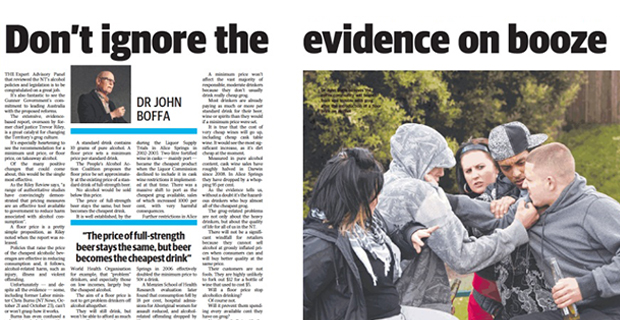The Expert Advisory Panel that reviewed the NT’s alcohol policies and legislation is to be congratulated on a great job.
It’s also fantastic to see the Gunner Government’s commitment to leading Australia with the proposed reforms.
The extensive, evidence-based report, overseen by former chief justice Trevor Riley, is a great catalyst for changing the Territory’s grog culture.
It’s especially heartening to see the recommendation for a minimum unit price, or floor price, on takeaway alcohol.
Of the many positive changes that could come about, this would be the single most effective.
As the Riley Review says, “a range of authoritative studies have convincingly demonstrated that pricing measures are an effective tool available to government to reduce harm associated with alcohol consumption”.
A floor price is a pretty simple proposition, as Riley noted when the report was released.
Policies that raise the price of the cheapest alcoholic beverages are effective in reducing consumption and, it follows, alcohol-related harm, such as injury, illness and violent offending.
Unfortunately — and despite all the evidence — some, including former Labor minister Chris Burns (NT News, October 21 and October 23), can’t or won’t grasp how it works.
Burns has even confused a volumetric alcohol tax with a floor price. A volumetric tax would apply nationally and is long overdue, but it is well established that only the Federal Government can legally introduce one.
The NT and the states are free to adjust prices locally rather than wait … and wait.
So how does it work?
A standard drink contains 10 grams of pure alcohol. A floor price sets a minimum price per standard drink.
The People’s Alcohol Action Coalition proposes the floor price be set approximately at the existing price of a standard drink of full-strength beer.
No alcohol would be sold below this price.
The price of full-strength beer stays the same, but beer becomes the cheapest drink.
It is well established, by the World Health Organisation for example, that “problem” drinkers, and especially those on low incomes, largely buy the cheapest alcohol.
The aim of a floor price is not to get problem drinkers off alcohol altogether.
They will still drink, but won’t be able to afford as much grog, will cause less harm to themselves and others, and cost the community less in dollars and social disruption.
This is what has happened in Canada, and also here in the Territory, in Alice Springs, where various supply measures have been used.
The effect of pricing on problem drinkers became clear during the Liquor Supply Trials in Alice Springs in 2002-2003. Two-litre fortified wine in casks — mainly port — became the cheapest product when the Liquor Commission declined to include it in cask wine restrictions it implemented at that time. There was a massive shift to port as the cheapest grog available, sales of which increased 1000 per cent, with very harmful consequences.
Further restrictions in Alice Springs in 2006 effectively doubled the minimum price to 50¢ a drink.
A Menzies School of Health Research evaluation later found that consumption fell by 18 per cent, hospital admissions for Aboriginal women for assault reduced, and alcohol-related offending dropped by 12 per cent.
A 10 per cent increase in the minimum price per unit in Saskatchewan Province, Canada, saw a reduction in consumption of more than 8 per cent, and mortality caused by alcohol went down by nearly a third in British Columbia.
The public health benefit is crystal clear.
A minimum price won’t affect the vast majority of responsible, moderate drinkers because they don’t usually drink really cheap grog.
Most drinkers are already paying as much or more per standard drink for their beer, wine or spirits than they would if a minimum price were set.
It is true that the cost of very cheap wines will go up, including cheap cask table wine. It would see the most significant increase, as it’s dirt cheap at the moment.
Measured in pure alcohol content, cask wine sales have roughly halved in Darwin since 2008. In Alice Springs they have dropped by a whopping 95 per cent.
As the evidence tells us, without a doubt it’s the hazardous drinkers who buy almost all of the cheapest grog.
The grog-related problems are not only about the heavy drinkers, but about the quality of life for all of us in the NT.
There will not be a significant windfall for retailers because they cannot sell alcohol at grossly inflated prices when consumers can and will buy better quality at the same price.
Their customers are not fools. They are highly unlikely to fork out $12 for a bottle of wine that used to cost $5.
Will a floor price stop alcoholics drinking?
Of course not.
Will it prevent them spending every available cent they have on grog?
No, it won’t. But, with the money they do have, they won’t be able to buy or drink as much, or do as much harm.
The NT Opposition has pledged its support for the Riley Review measures, and even the Australian Hotels Association supports most of the recommendations.
It’s worth checking them out. As Michael Gunner said, it’s time to tear up the Liquor Act and start again.
The Chief Minister, Health Minister Natasha Fyles and their colleagues must continue to lead on the alcohol issue.
The entire community will benefit from less trouble with grog. The debate must be based on evidence and data, not on misunderstandings about a floor price.
Interestingly, the Productivity Commission has just released its latest report on what Australia needs to do to improve productivity over the next five years. It concludes that if we don’t have a federal volumetric alcohol tax, then we must have floor prices in the states and territories.
Let’s get going on the NT being the first.
The cost of the alternative is too great, in both monetary and human measures.








Add comment